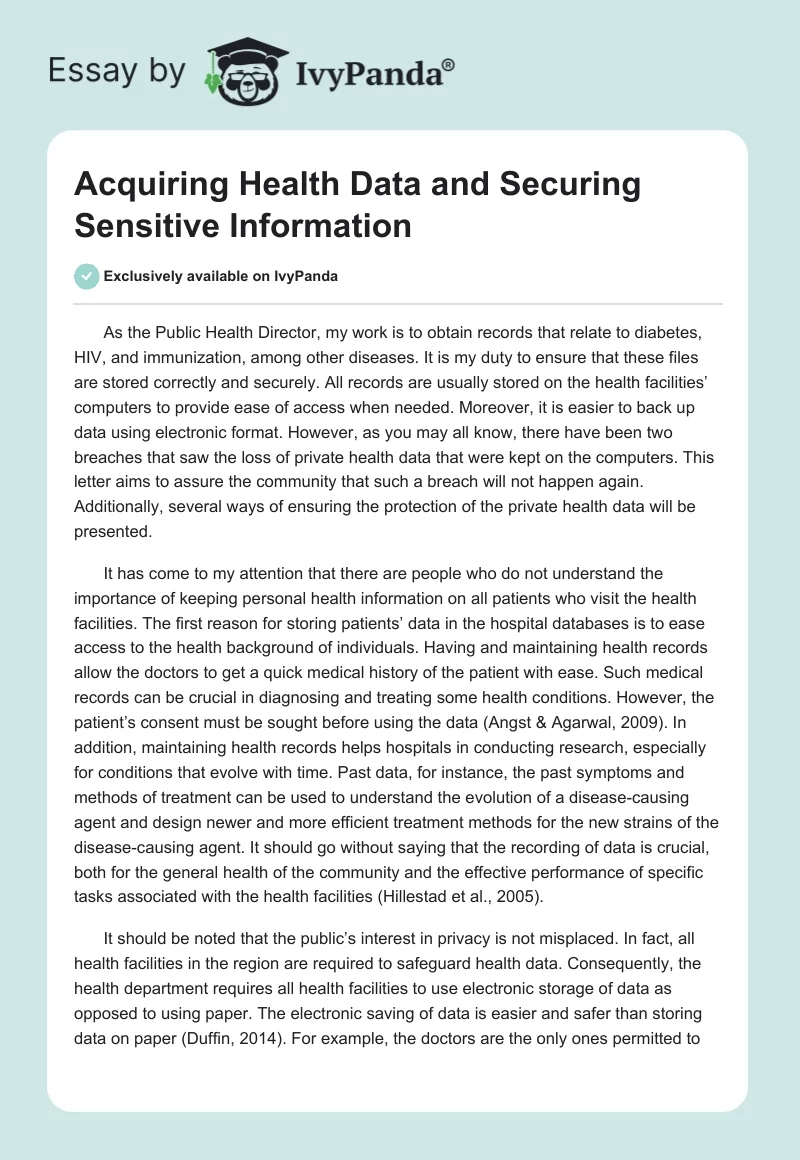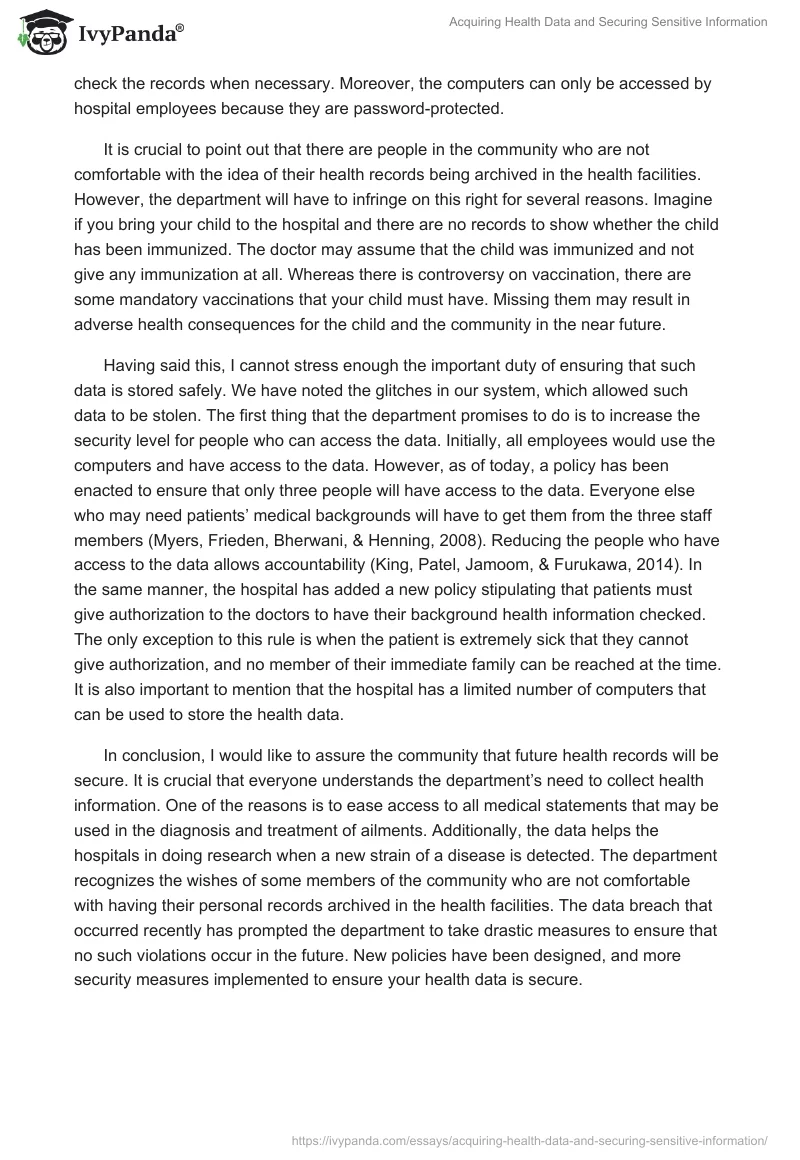As the Public Health Director, my work is to obtain records that relate to diabetes, HIV, and immunization, among other diseases. It is my duty to ensure that these files are stored correctly and securely. All records are usually stored on the health facilities’ computers to provide ease of access when needed. Moreover, it is easier to back up data using electronic format. However, as you may all know, there have been two breaches that saw the loss of private health data that were kept on the computers. This letter aims to assure the community that such a breach will not happen again. Additionally, several ways of ensuring the protection of the private health data will be presented.
It has come to my attention that there are people who do not understand the importance of keeping personal health information on all patients who visit the health facilities. The first reason for storing patients’ data in the hospital databases is to ease access to the health background of individuals. Having and maintaining health records allow the doctors to get a quick medical history of the patient with ease. Such medical records can be crucial in diagnosing and treating some health conditions. However, the patient’s consent must be sought before using the data (Angst & Agarwal, 2009). In addition, maintaining health records helps hospitals in conducting research, especially for conditions that evolve with time. Past data, for instance, the past symptoms and methods of treatment can be used to understand the evolution of a disease-causing agent and design newer and more efficient treatment methods for the new strains of the disease-causing agent. It should go without saying that the recording of data is crucial, both for the general health of the community and the effective performance of specific tasks associated with the health facilities (Hillestad et al., 2005).
It should be noted that the public’s interest in privacy is not misplaced. In fact, all health facilities in the region are required to safeguard health data. Consequently, the health department requires all health facilities to use electronic storage of data as opposed to using paper. The electronic saving of data is easier and safer than storing data on paper (Duffin, 2014). For example, the doctors are the only ones permitted to check the records when necessary. Moreover, the computers can only be accessed by hospital employees because they are password-protected.
It is crucial to point out that there are people in the community who are not comfortable with the idea of their health records being archived in the health facilities. However, the department will have to infringe on this right for several reasons. Imagine if you bring your child to the hospital and there are no records to show whether the child has been immunized. The doctor may assume that the child was immunized and not give any immunization at all. Whereas there is controversy on vaccination, there are some mandatory vaccinations that your child must have. Missing them may result in adverse health consequences for the child and the community in the near future.
Having said this, I cannot stress enough the important duty of ensuring that such data is stored safely. We have noted the glitches in our system, which allowed such data to be stolen. The first thing that the department promises to do is to increase the security level for people who can access the data. Initially, all employees would use the computers and have access to the data. However, as of today, a policy has been enacted to ensure that only three people will have access to the data. Everyone else who may need patients’ medical backgrounds will have to get them from the three staff members (Myers, Frieden, Bherwani, & Henning, 2008). Reducing the people who have access to the data allows accountability (King, Patel, Jamoom, & Furukawa, 2014). In the same manner, the hospital has added a new policy stipulating that patients must give authorization to the doctors to have their background health information checked. The only exception to this rule is when the patient is extremely sick that they cannot give authorization, and no member of their immediate family can be reached at the time. It is also important to mention that the hospital has a limited number of computers that can be used to store the health data.
In conclusion, I would like to assure the community that future health records will be secure. It is crucial that everyone understands the department’s need to collect health information. One of the reasons is to ease access to all medical statements that may be used in the diagnosis and treatment of ailments. Additionally, the data helps the hospitals in doing research when a new strain of a disease is detected. The department recognizes the wishes of some members of the community who are not comfortable with having their personal records archived in the health facilities. The data breach that occurred recently has prompted the department to take drastic measures to ensure that no such violations occur in the future. New policies have been designed, and more security measures implemented to ensure your health data is secure.
References
Angst, C. M., & Agarwal, R. (2009). Adoption of electronic health records in the presence of privacy concerns: The elaboration likelihood model and individual persuasion. MIS Quarterly, 33(2), 339-370.
Duffin, C. (2014). Electronic system helps trusts to track patients on the move. Mental Health Practice, 17(6), 8-9.
Hillestad, R., Bigelow, J., Bower, A., Girosi, F., Meili, R., Scoville, R., & Taylor, R. (2005). Can electronic medical record systems transform health care? Potential health benefits, savings, and costs. Health Affairs, 24(5), 1103-1117. doi:10.1377/hlthaff.24.5.1103
King, J., Patel, V., Jamoom, E. W., & Furukawa, M. F. (2014). Clinical benefits of electronic health record use: National findings. Health Services Research, 49(1pt2), 392-404. doi:10.1111/1475-6773.12135
Myers, J., Frieden, T. R., Bherwani, K. M. & Henning, K. J (2008). Privacy and public health at risk: Public health confidentiality in the digital age. American Journal of Public Health, 98(5): 793 – 795.


